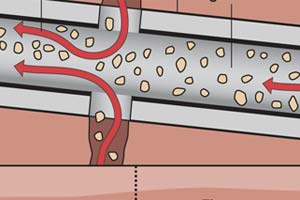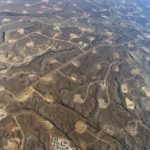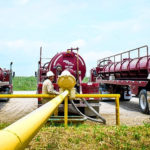
Here is the link to EPA’s study on Hydraulic Fracturing.
EPA Wants to Look at Full Lifecycle of Fracking in New Study
Published by ProPublica
By Nicholas Kusnetz
The EPA has proposed examining every aspect of hydraulic fracturing, from water withdrawals to waste disposal, according to a draft plan the agency released Tuesday. If the study goes forward as planned, it would be the most comprehensive investigation of whether the drilling technique risks polluting drinking water near oil and gas wells across the nation.

The agency wants to look at the potential impacts on drinking water of each stage involved in hydraulic fracturing, where drillers mix water with chemicals and sand and inject the fluid into wells to release oil or natural gas. In addition to examining the actual injection, the study would look at withdrawals, the mixing of the chemicals, and wastewater management and disposal. The agency, under a mandate from Congress, will only look at the impact of these practices on drinking water.
The agency’s scientific advisory board will review the draft plan on March 7-8 and will allow for public comments then. The EPA will consider any recommendations from the board and then begin the study promptly, it said in a news release. A preliminary report should be ready by the end of next year, the release said, with a full report expected in 2014.
A statement from the oil and gas industry group Energy in Depth gave a lukewarm assessment of the draft.
“Our guys are and will continue to be supportive of a study approach that’s based on the science, true to its original intent and scope,” the statement read. “But at first blush, this document doesn’t appear to definitively say whether it’s an approach EPA will ultimately take.”
The study, announced in March, comes amid rising public concern about the safety of fracking, as ProPublica has been reporting for years. While it remains unclear whether the actual fracturing process has contaminated drinking water, there have been more than 1,000 reports around the country of contamination related to drilling, as we reported in 2008. In September 2010, the EPA warned residents of a Wyoming town not to drink their well water and to use fans while showering to avoid the risk of explosion. Investigators found methane and other chemicals associated with drilling in the water, but they had not determined the cause of the contamination.
Drillers have been fracking wells for decades, but with the rise of horizontal drilling into unconventional formations like shale, they are injecting far more water and chemicals underground than ever before. The EPA proposal notes that 603 rigs were drilling horizontal wells in June 2010, more than twice as many as were operating a year earlier. Horizontal wells can require millions of gallons of water per well, a much greater volume than in conventional wells.
One point of contention is the breadth of the study. Chris Tucker, a spokesman for Energy in Depth, said he understands the need to address any stage of the fracking that might affect drinking water, but he’s skeptical that water withdrawals meet the criteria.
“The only way you can argue that issues related to water demand are relevant to that question is if you believe the fracturing process requires such a high volume of water that its very execution threatens the general availability of the potable sources,” he wrote in an e-mail.
The EPA proposal estimates that fracking uses 70 to 140 billion gallons of water annually, or about the same amount used by one or two cities of 2.5 million people. In the Barnett Shale, in Texas, the agency estimates fracking for gas drilling consumes nearly 2 percent of all the water used in the area.
The EPA proposes using two or three “prospective” case studies to follow the course of drilling and fracking wells from beginning to end. It would also look at three to five places where drilling has reportedly contaminated water, including two potential sites in Pennsylvania’s Marcellus Shale, and one site each in Texas, Colorado and North Dakota.














Pingback: Natural Gas Fracking: Environmental Backlash Grows | wilderutopia.com
Pingback: Shale Gas Boom Triggers Poisoned-Water Gold Rush | WilderUtopia.com